IMO Workshop Artwork
The artwork for the IMO workshop was important from the very beginning. As mathematical modellers at the interface of multiple disciplines, it was critical that the artwork appealed to everyone at the same time as conveying clearly what our workshop was about. We certainly didn’t want these posters to simply be a calendar item. Jill Gallaher has been a key creative force in my lab and is the central thread running through everyone of these pieces. We picked up some other artists along the way that also helped out with the lions share of these pieces: Arturo Araujo and Chandler Gatenbee. Each brought an aesthetic that was distinct and complimentary, its been a real pleasure to work with them over the last decade. Below is a description of each poster and details on who did what, at the end we have short bios for each of these 3 key contributors. One final point, some posters have easter eggs hidden within them - can you spot any?
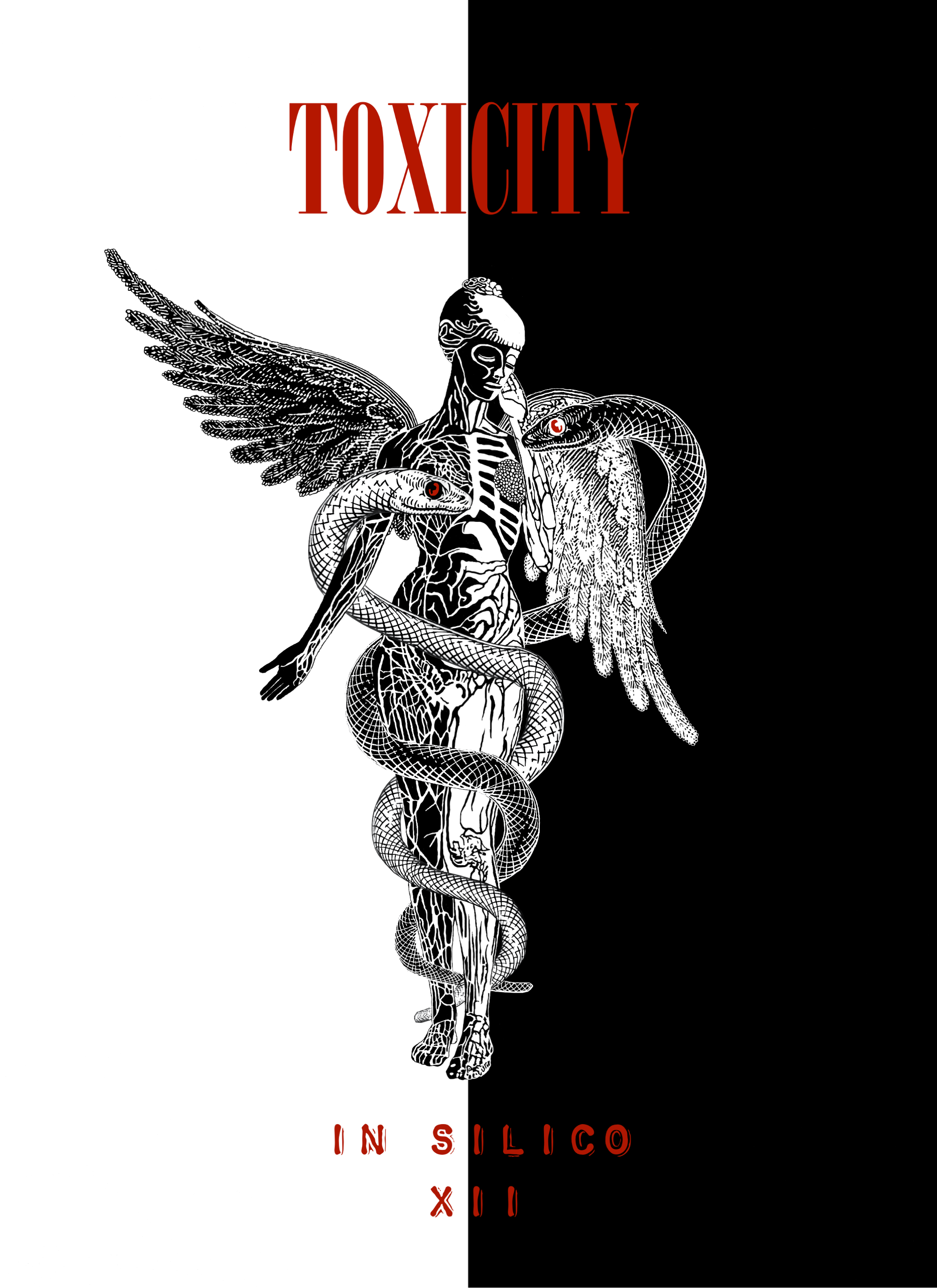
12. Toxicity
This workshop’s theme was "Toxicity." Deriving inspiration from Nirvana’s In Utero cover art, we created this piece. The angel was split into black and white to represent how cancer treatments must balance conflicting components of healing with toxicity. The downturned wing and head suggest the latter in tension with the outstretched opposing former. This aspect of balance extends to all of medicine, for which the symbolism of the caduceus with its rod and snakes is also represented here. The snakes themselves have been associated with shedding skin, healing, and transformation and their toxic venom. The colors and composition style were also inspired by the artwork on the Scarface movie poster.
Conceptualization: Jill Gallaher, Chandler Gatenbee, Sandy Anderson
Design, graphics: Jill Gallaher
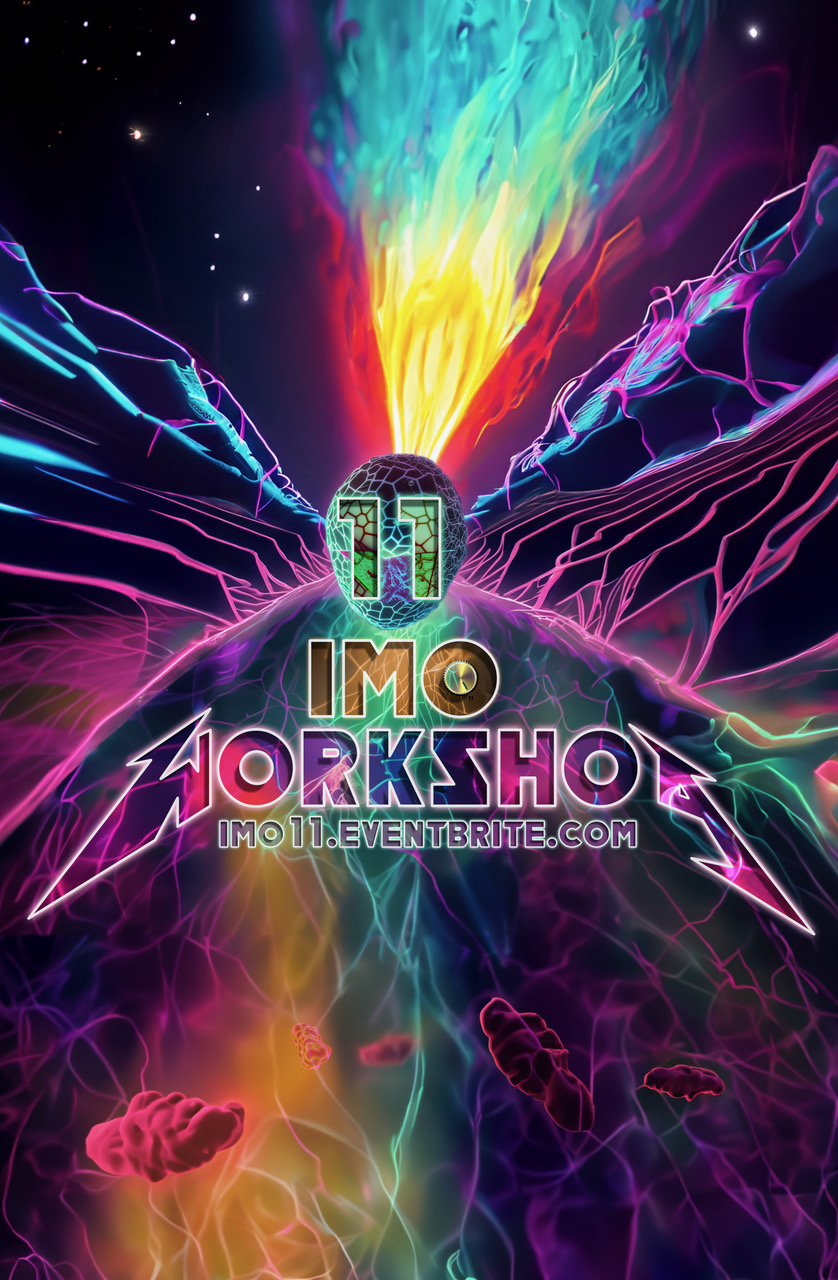
11. Steering Evolution/Extinction
This workshop’s theme was "Steering Evolution/Extinction."
Conceptualization: Jill Gallaher, Chandler Gatenbee, Sandy Anderson
Design, graphics: Jill Gallaher, Chandler Gatenbee, Sandy Anderson
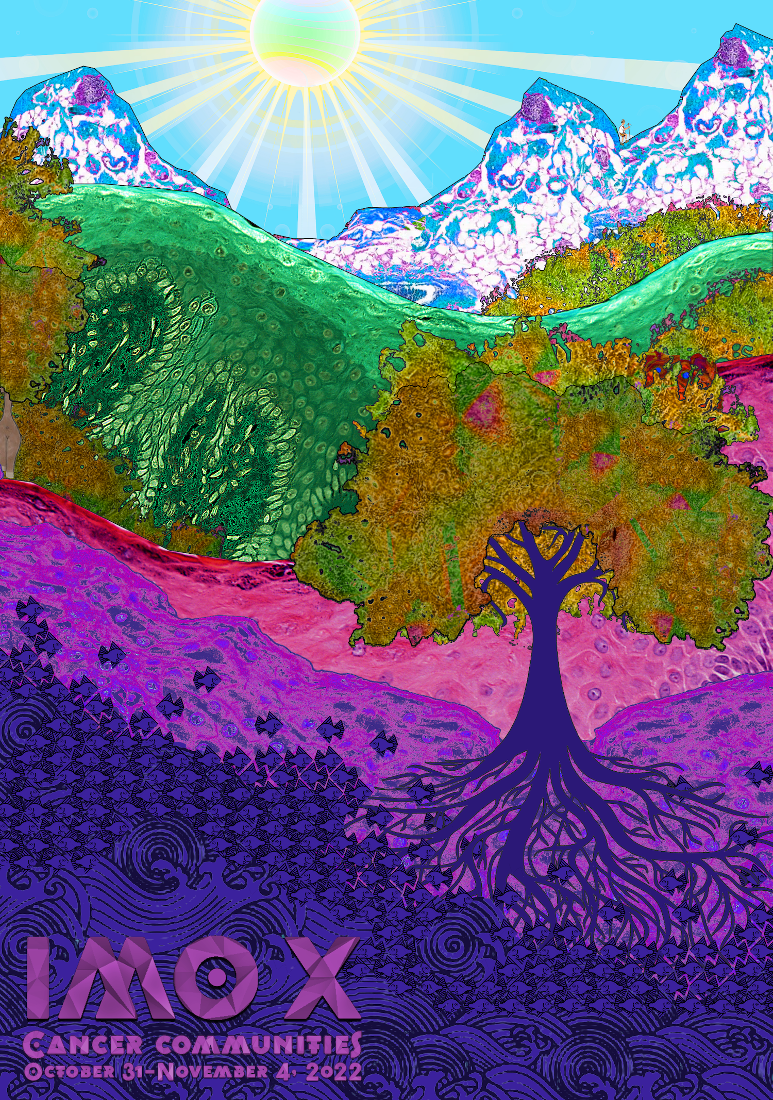
10. Cancer communities
This workshop’s theme was "Cancer Communities." In this artwork we have tried to capture this theme by integrating elements of community into a mountainous landscape, reflecting the similarities between the ecosystems around us and those within patients afflicted by the disease. The landscape is created from actual tumor histology which neighbors a stream with tessellated fish. The tree’s trunk may represent vasculature interfacing bloodstream with tissue, and the circos plot speaks to the interactions between these elements.
Conceptualization: Jill Gallaher, Chandler Gatenbee, Sandy Anderson, Maximilian Strobl
Design, graphics: Jill Gallaher, Chandler Gatenbee, Sandy Anderson, Maximilian Strobl
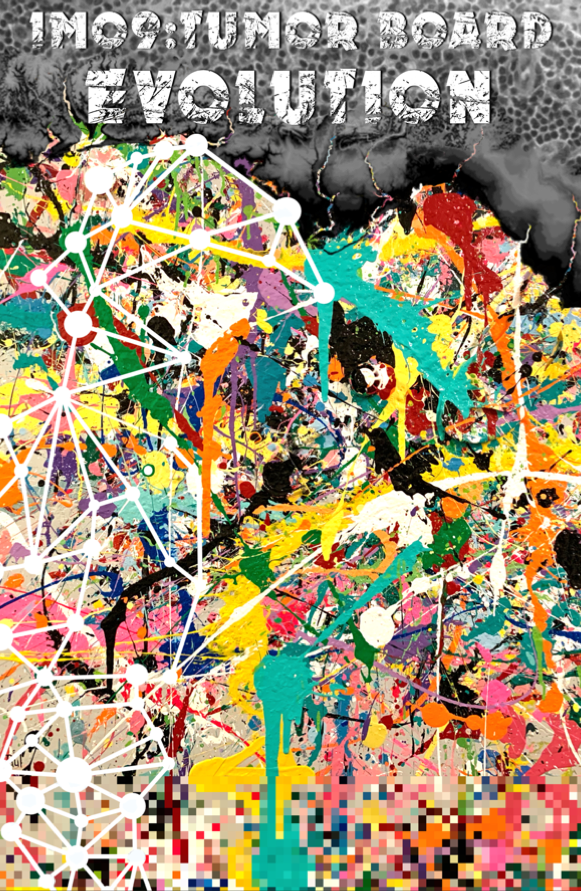
9. Tumor board evolution
This piece was a collaboration between Ray Paul, who is an artist, a friend of the IMO, and a patient advocate at Moffitt Cancer Center, and Jill Gallaher, a research scientist in the IMO. The multi-colored splatter artwork is a signature of Ray, which in this context, to us, represents cancer’s chaos and heterogeneity. Along the top and upper right, we see the coastline of Florida mixing into an actual image of Ray Paul’s sarcoma histology. This represents more of our department’s ecological/landscape view of cancer and the abstraction of biological mechanisms to make mathematical models. The white network on the right also represents mathematical abstraction and predictions, which also hints at the idea of hurricanes prominent in the Gulf of Mexico and around Florida and its connection to creating predictive models.
Conceptualization: Ray Paul, Jill Gallaher, Chandler Gatenbee, Sandy Anderson
Design, graphics: Ray Paul, Jill Gallaher

8. Evolutionary therapy
With the focus of this workshop on evolution, we created this piece to highlight our perspective of cancer through a Darwinian evolutionary lens. In this, we depict Charles Darwin manipulating phylogenetic trees as if they were marionettes, whilst the trees spell out “IMO WORKSHOP”. Because this was the 8th annual workshop, we have hanging in the middle an “8”, which is also a rotated infinity symbol, and which is also part of the logo created for our Center of Excellence in Evolutionary Therapy.
Conceptualization
Conceptualization: Jill Gallaher, Chandler Gatenbee, Sandy Anderson
Design, graphics: Jill Gallaher, Chandler Gatenbee
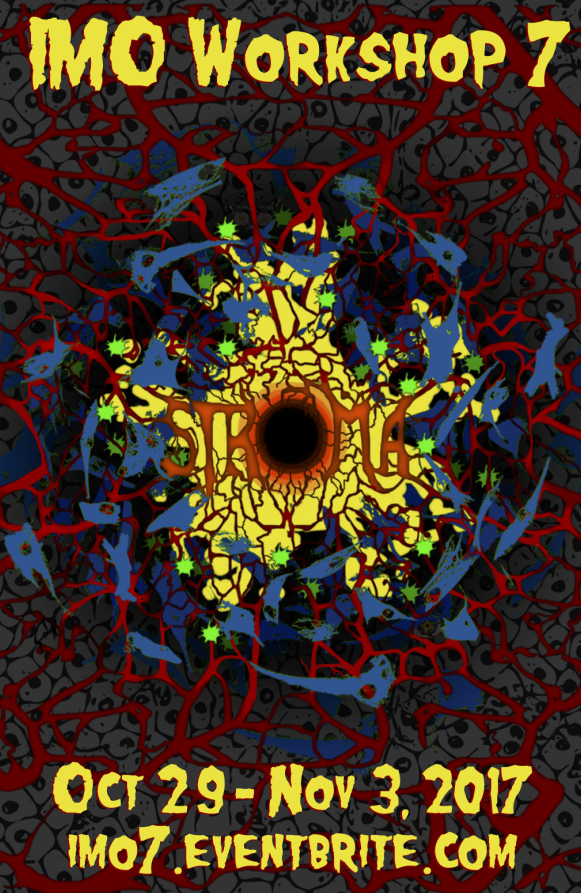
7. Stroma
In the 7th annual workshop, we focused on tumor stroma - all of the elements involved in cancer that are not tumor cells. The center black circle represents the necrotic center of a tumor, which is surrounded by living tumor colored from red to yellow. The vasculature is feeding the tumor throughout and spells out the word “STROMA”. Fibroblasts and immune cells surround the tumor in blue and green, respectively, and the normal surrounding tissue is colored gray. Because the workshop was happening over halloween, we chose a somewhat creepy font.
Conceptualization: Jill Gallaher, Chandler Gatenbee, Ryan Schenck, Sandy Anderson
Design, graphics: Jill Gallaher
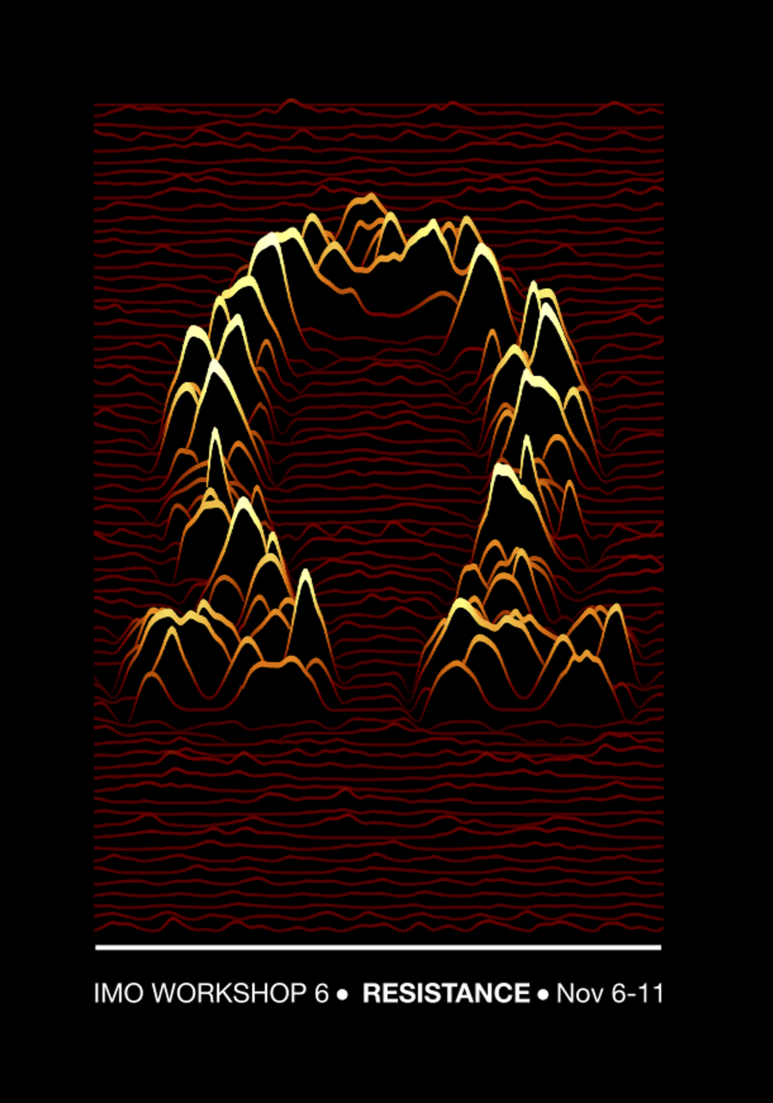
6. Resistance
Inspired by Joy Division’s Unknown Pleasures album cover that shows radio frequency profiles of pulsars, we created similar frequency bursts in the shape of the physics symbol for resistance. This is actually a single frame taken from a movie that has sound waves that correspond to frequency profiles.
Conceptualization: Chandler Gatenbee, Ryan Schenck, Jill Gallaher, Sandy Anderson
Programming, design, graphics: Chandler Gatenbee, Ryan Schenck
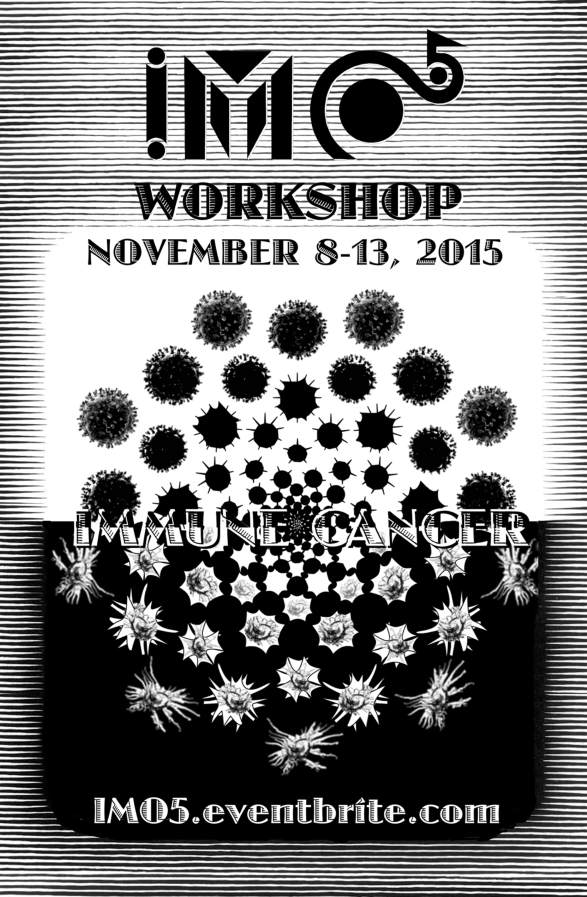
5. Immune cancer
This figure was inspired by the work of M.C. Escher. The way that immune cells and tumor cells can be thought of as existing in a continuum of plastic states of different differentiation seemed to connect to the way that Escher created tessellations of objects that morphed into other objects, such as in the work called Sky and Water I, which was the inspiration for this work. Instead of birds and fish, a similar theme was created using 2 types of immune cells, that appear to stem from the same undifferentiated state in the center. The outer frame is actually a digitally manipulated version from Escher’s piece. The logo was created by Chandler Gatenbee and represents abstractions of immune cells and receptors.
Conceptualization: Jill Gallaher, Chandler Gatenbee, Sandy Anderson
Logo creation: Chandler Gatenbee
Drawing, design, graphics: Jill Gallaher
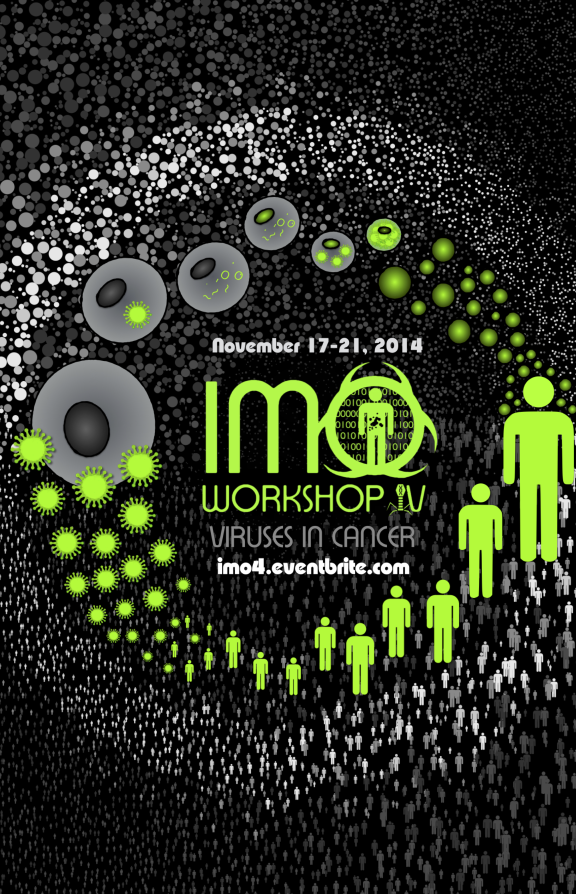
4. Viruses in cancer
In infectious disease, as in cancer viruses, the bridging of scales in modelling is important. It’s not just the cell and tissue scales, but also the population scale that needs to be considered. The circle here represents the reproduction cycle of the virus, which uses the machinery of the cell and then transfers to others in the population again and again. This was created from code which was designed to create color blindness vision tests. However, here the different colors and sizes are meant to convey heterogeneity in cells and patients.
Conceptualization: Jill Gallaher, Arturo Araujo, Sandy Anderson
Logo creation: Arturo Araujo
Design, graphics, programming: Jill Gallaher
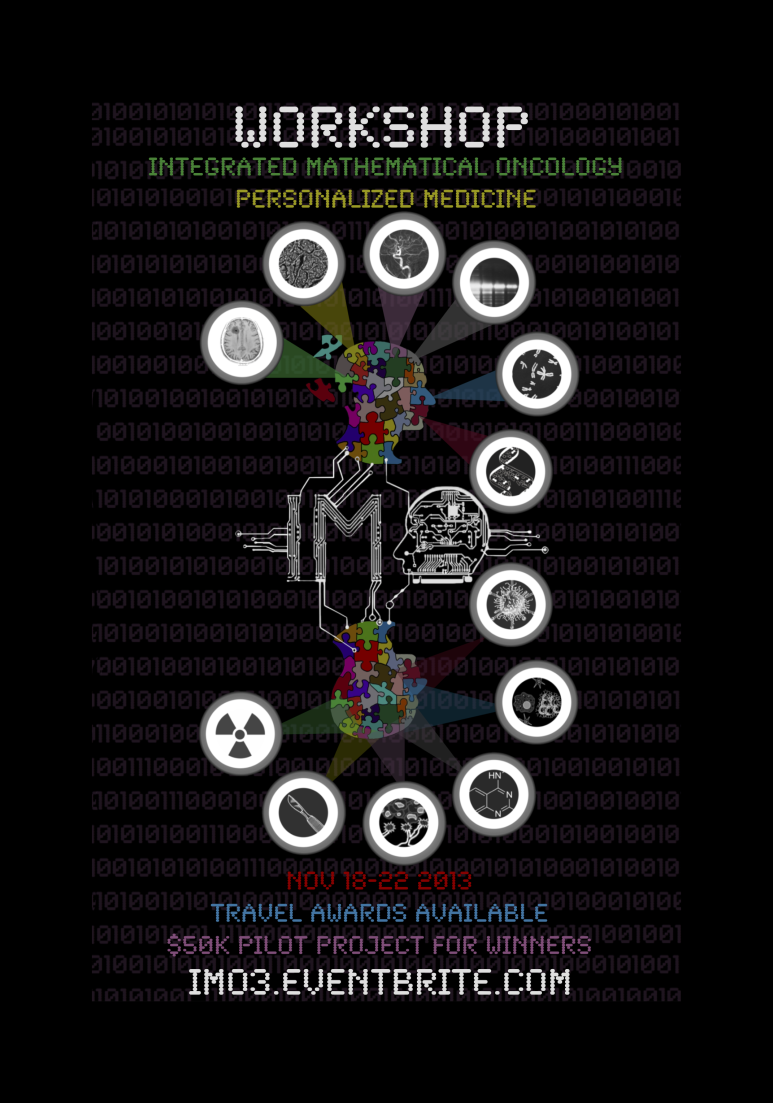
3. Personalized Medicine
For the 3rd annual workshop, we created a representation of how a patient’s data can be integrated into mathematical models to inform personalized treatments, which is also in the shape of a “3”. The top portion shows a person’s head made of colored puzzle pieces to represent a patient’s unique features, which are mapped above in circles. This includes from the left to the right: imaging, histology, an angiogram, Western blot, chromosomes, and DNA. These feed into the integrated circuit representation of the “IMO”, which feeds into the bottom portion containing the treatments. From left to right these include: radiation therapy, surgery, anti-angiogenic treatment, chemotherapy, immunotherapy, and viral therapy. This is all laid upon a background of 1's and 0's to fit with the circuitry theme.
Conceptualization: Arturo Araujo, Jill Gallaher, and Sandy Anderson
Design, graphics: Arturo Araujo, Jill Gallaher
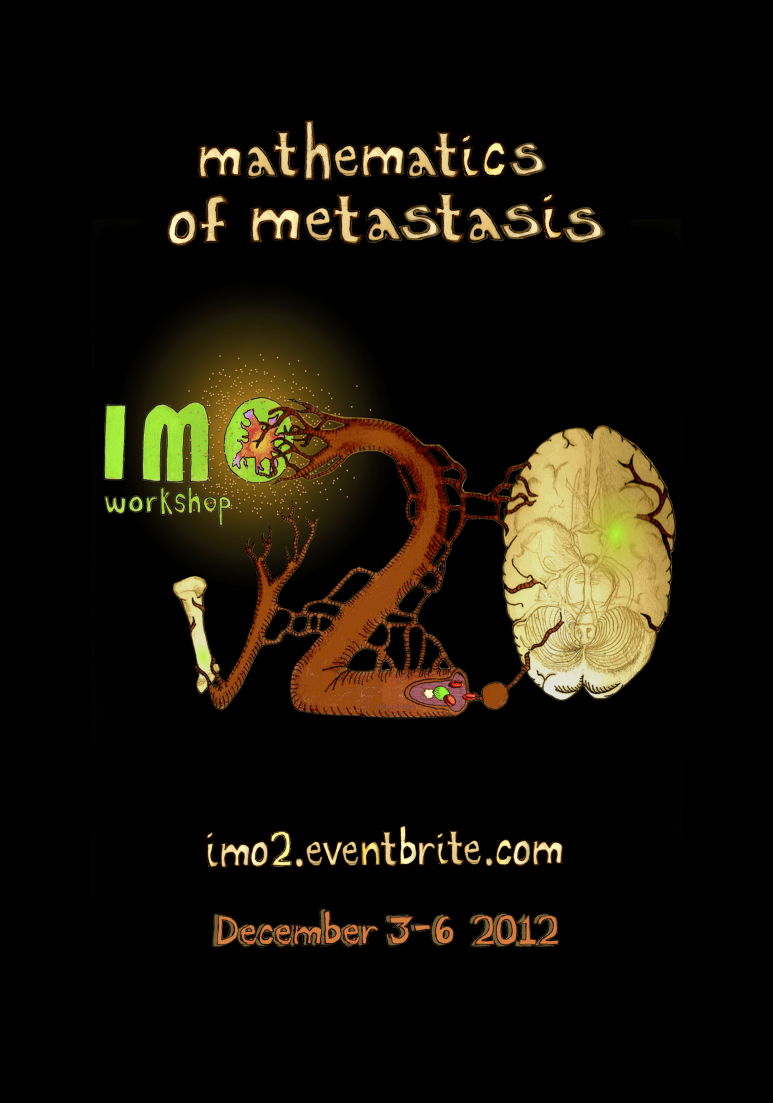
2. Metastasis
We called this workshop v2.0, playing on software versioning terminology to name the 2nd iteration of the annual workshop, which is spelled out portraying the different steps and stages of cancer progression toward metastatic disease. The “O” in IMO logo here represents a primary tumor which interacts with and feeds into the vasculature system, which feeds into some of the most commonly disseminated organs, the bone and the brain. In the cutaway of the vessel, blood cells, immune cells, and disseminated tumor cells are seen. The style of this artwork was inspired by the sketches and scientific diagrams of Leonardo daVinci. The different pieces were drawn, digitally manipulated, pieced together, and enhanced.
Conceptualization: Jill Gallaher, Sandy Anderson
Drawing, design, graphics: Jill Gallaher

1. Targeting therapy
The very first IMO workshop dealt with targeted cancer therapies. The artwork plays on the idea of computerized weaponry and targeting to relate to the idea of precision medicine applied to tumors by identifying patient-specific therapies. The tumor picture (lifted from somewhere in the internets) is flanked by zoomed-in areas, which contain simulations from our group (left: Eunjung Kim’s lattice-based model, top-right: Kasia Rejniak’s mechanics-based Pott’s model, bottom-right: Jill Gallaher’s off-lattice hybrid model).
Conceptualization: Jill Gallaher, Edward Flach, Sandy Anderson
Graphics, design: Jill Gallaher
The artists
Jill Gallaher
Jill is a Research Scientist in the Integrated Mathematical Oncology department at Moffitt Cancer Center, where she studies tumor heterogeneity, evolution, and drug resistance. She uses mainly spatial agent-based models to investigate these concepts in terms of cell-cell interactions and competition with a special interest in glioblastoma and prostate cancer. Her undergraduate background was in biology, biochemistry, and art before finishing with a BS in physics. During her PhD work in biomedical physics at East Carolina University, she worked on theoretical models of ion traffic and membrane thermodynamics with Martin Bier. She then started at IMO as a Postdoctoral Fellow with Sandy Anderson investigating tumor heterogeneity, phenotypic inheritance, and tradeoffs. The importance of collaboration, visualization, and art in understanding and communicating complex problems is apparent when bringing together diverse groups of researchers. The IMO workshop art that is created every year is a result of these collaborations. More of her work can be found at https://www.jillgallaher.com/art.
Arturo Araujo
Arturo is a postdoctoral researcher at the Computer Science department of University College London (UCL) and senior research fellow at the Artificial Intelligence research company TheAIWorks Ltd. Arturo was awarded a PhD from UCL’s CoMPLEX (Centre for Computation, Mathematics and Physics in the Life Sciences and Experimental Biology), where he devised a mathematical theory, carried out the lab experiments and programmed the computational model to investigate the role of chromosome missegregation in cancer. He then gained 5 years of invaluable experience at the IMO department at Moffitt Cancer Center where, in close collaboration with biologists and clinicians, successfully modelled the vicious cycle of Prostate Cancer to Bone Metastasis at the interphase between mathematics, biology and the clinic. During his time at the IMO Arturo worked together with Jill Gallaher and Sandy Anderson to distill the essence of IMO Workshops into a single visual vision. Like with all the IMO ventures, the iconic results are much greater than the sum of the parts. Arturo is grateful to have been part of the IMO workshop art team and you can see some of his current work at www.arturoaraujo.com.
Chandler Gatenbee
Chandler is a research scientist in the Department of Mathematical Oncology at the Moffitt Cancer Center in Tampa, Florida. He earned an M.S. in Biological Anthropology (University of Utah) and Ph.D in Biology (University of Louisville), and now uses computational models and image analysis to study the eco-evolutionary dynamics of cancer to better understand tumorigenesis, the evolution of resistance, and response to treatment. He also has a lifelong love for a wide variety of musical genres that, when combined with his research interests, often provide the inspiration for his contributions to the workshop artwork. He has participated in six IMO workshops, and always comes away having gained new skills and a deeper appreciation for the challenges involved in real-world cancer treatment.
